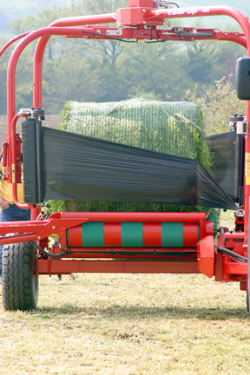
Recently released findings from a scientific experiment undertaken at IGER clearly demonstrate the very real benefits of using additional layers of bale wrap on silage bales. The experimental data has shown that increasing the layers of bale wrap from 4 to 6 improved fermentation, reduced moulds, improved the oxygen barrier and reduced dry matter losses. IGER report that the differences observed are highly statistically significant. This is the first comprehensive experiment of its kind, evaluating film layering at different dry matter contents, that has given conclusive evidence that increasing film layers result in significant improvements
Grass was ensiled at 30 % DM, 40% DM and 50% DM (24 hour, 48 hour and 72 hour wilt respectively), and at each stage bales were wrapped in either 4, 6 or 8 layers of black bale wrap. All bales were wrapped using black Silotite bale wrap. Film seal, mould coverage, silage chemical analysis and dry matter recovery were all assessed following the 180 day storage period.
Increasing the wilting period resulted in a reduction in surface mould on the bales. As expected, silage pH was higher in response to increased wilting. Silage ammonia-N, lactate and acetate concentrations decreased in response to increased wilting. Residual sugar was highest in the higher dry matter bales.
Applying 6 layers of black film significantly reduced mould coverage on the bales compared to applying 4 layers but applying 8 layers resulted only in a small reduction when compared with applying 6 layers.
Increasing the film layers applied resulted in significantly more dry matter being recovered after the ensiling period. Whilst no difference was observed in ammonia-N content between film layering treatments, both lactate and acetate content reduced with increased layering due to the more efficient fermentation which occurred when more film layers were used.
The residual sugar content of the silage was greater with increased wilting. Residual sugar was also greater in response to increasing film layers applied. All these positive benefits observed by increasing film layers are due to the better seal achieved, reducing oxygen ingress into the bale and protecting the bale from physical damage. This improved sealing results in a more efficient fermentation resulting in less sugar being utilised during the fermentation process.
The dramatically improved sugar content was particularly interesting as previous work at IGER has shown that higher sugar levels improve the way the rumen works enabling better conversion of forage protein into meat and milk. This more efficient utilisation of protein in the silage means not only more production but also gives environmental benefits by reducing nitrogen excretion.
IGER have assessed the financial returns of applying both 6 layers and 8 layers of black film when wrapping. The extra cost which includes the film, it's application and disposal was calculated at £0.71 per bale for 6 layers and £1.43 for 8 layers. The cost saving achieved in terms of the value of the extra dry matter recovered and sugar recovered was calculated at £1.37 and £2.52 respectively which means that the applications of 6 layers gives a return on cost of 92% for 6 layers and 76% for 8 layers. In summary:
Additional cost
£ Cost saving achieved
£ Return on cost
%
6 layers 0.71 1.37 92
8 layers 1.43 2.52 76
The trial was one of the last research experiments to have been conducted by Raymond Jones, leader of IGER's Land Use and Integrated Livestock Systems team and an internationally acknowledged authority on forage conservation. Raymond sadly passed away suddenly in May this year. His colleague Rhun Fychan added: "These findings add to the extensive research on forage conservation which Raymond and his team had developed over the years. It is pleasing that this rigorous trial has demonstrated additional benefits of the bale wrapping process, and is a platform for us to carry on with silage research in Raymond's memory".
The trial was jointly funded by bpi.agri, manufacturers of Silotite and Dow Europe. John Lancaster, Commercial Director of bpi.agri commented: "We are pleased to have sponsored this important trial. Although the benefits of applying extra film layers have been testified to anecdotally by many in the industry, it is good to have conclusive data to verify this scientifically".
